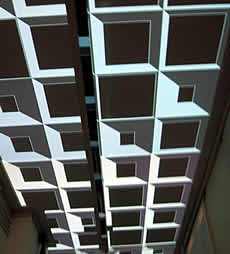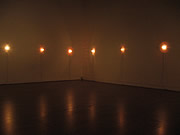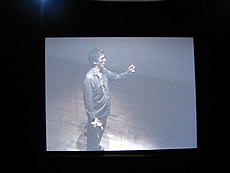sensorium
july 18, 2006.
[ video ]
As part of the 5 Days Off Media festival that took place in Amsterdam at various locations between july 12th and 16th, Montevideo/Time Based Arts - the Netherlands Media Art Institute - at the Keizersgracht hosted "Sensorium": two hands full of "interactive installations, single channel projects, spacious objects and live image and sound performances".
 I spent a fun hour there, saturday afternoon. For one, I welcomed the opportunity to escape for a while from the hot and
dusty city streets, and swap the fine-but-as-always city sounds for something different.
I spent a fun hour there, saturday afternoon. For one, I welcomed the opportunity to escape for a while from the hot and
dusty city streets, and swap the fine-but-as-always city sounds for something different.
Something noisy as well. Yes, at times even noisier. But it nevertheless was a refreshingly quiet visit. Most of the hour I spent in the mostly dusky
exhibition space, I spent without another soul in sight.
Good for me. Even though I sincerely hope that many others did come to see and listen.
Much of the fun was due to the fact that most of the works demanded that you do something in order to hear. (That's 'interactivity', hein :-) ( * )...)
In order to hear Edwin van der Heide's Sound Modulated Light
at the entrance one is handed a biggish metal box with a light sensor, a volume control and a pair of headphones.
 "Normal lamps connected to the electricity network," he explains on his website, "flicker at an (almost) invisible
frequency of 50 Hz. The latter can be seen as a carrier for a (rectified) 50 Hz sound ..."
Edwin's installation consists in
a series of equally spaced identical lamps, attached at approximately waist height to the walls around a room, whose light
functions as 'sound carrier': for each lamp a sound is modulated on top of the light by means of intensity modulation. Sort of like
a cute variation on the principle of radio... the sounds then are made audible again by means of a 'light receiver' ...
"Normal lamps connected to the electricity network," he explains on his website, "flicker at an (almost) invisible
frequency of 50 Hz. The latter can be seen as a carrier for a (rectified) 50 Hz sound ..."
Edwin's installation consists in
a series of equally spaced identical lamps, attached at approximately waist height to the walls around a room, whose light
functions as 'sound carrier': for each lamp a sound is modulated on top of the light by means of intensity modulation. Sort of like
a cute variation on the principle of radio... the sounds then are made audible again by means of a 'light receiver' ...
But it was not this Sound Modulated Light space, it
were the loud beats, the clickings and cracklings, and the fast irregular flickering of black lines along a white screen that imposed themselves
first when I stepped onto the exhibition floor at Montevideo's. Big speakers and a wall sized screen in a dark room, with a comfortable
two seater to sit, listen and look. On the door a whole lot of paper with a whole lot of words explaining Jan Peter Sonntag's
SonArc::ion, probably the most 'demanding' work at the Sensorium. At the time I did not have the patience to read all
of that, I'm sorry...
There were two video's playing. One of them (playing when I arrived)
being (part of ?) of the work, the second documentary in nature. Looked intriguing, and sounded great. Hope I'll get a second occasion
to see and hear Sonntag's work. For now - to give you an idea - let me just quote from an abstract of his talk at the 'Electromagnetic Bride' conference,
which took place early may 2006 Rotterdam:
"[SonArc::ion is a] trans-disciplinary art and research project involving the coding of plasmas, theories about the ether and the question of the nature of electricity. The installation's laboratory part revolves around the sonArcs - the very minimal interfaces between a person as a partly electrical system and an artificial electrical system in space. Based on the first 'electronic' musical instrument created by William Duddell (**), they remain the first/only purely electrical/electronic instrument: a high-voltage plasma is produced between two electrodes which generates electromagnetic waves of a broad spectrum - it lights up, gives off sounds, broadcasts and receives = it transmits. "sonArc::ion - prolog", which was first carried out at TESLA Berlin in 2005, involves the production of a machine - an electrical system on a 10-metre table, on which a composition of over 140 minutes in length is played. Based on an extension of the RAW data sets of the post-serial composition studie2 by Stockhausen in the form of video and sound created with the help of AEG Page 4 and EEG sensors, 11 analogue sine-wave generators, three noise generators, numerous open oscillating circuits, light bulbs from over 100 years, interspersed with ether theories from around 1900 on a wide variety of magnetic storage media, a rearward-directed arc is formed until there are just two arcs communicating with each other in space by means of digitally spoken hexa data sets."
From the SonArc::ion room I stepped into Bill Spinhoven and Michiel van Bakel's
'Time Ring', which - surely a coincidence, but still remarkable - for its sound generating part also
'harks back to' a classic from electronic music's pioneering days, the
theremin.

On the ceiling of the time ring space, there's a large circle of cameras watching you moving around. In the circle's center,
there's the theremin, brought into action by your 'electromagnetic presence', and which in turn steers the order of the
camera's recording and the projection of recorded images, past and present.
Great to play around with. Maybe not the most subtle, but on first encounter the most 'sensational' of the Sensorium's
'high tech toys' ... [ I recorded a short 'one take video clip' with my camera. You can click the picture to see it (quicktime, avi),
or download the file. ]
And all the time I walked around there with headphones and the 'light receiver' switched on, at first not aware what it actually was, and that it was specifically intended for use with the Sound Modulated Light room ... I just pointed the gadget at whatever, to see what happens. And so soon I found out that it - of course - 'worked' with any of the light sources around. I also found it useful for 'playing' the Time Ring 's theremin, and the light from the projectors used by Jan Robert Leegte for his installation in the corridor produced differently pitched sounds, like that of car horns, and pointing the light receiver at the projector lights while walking along the corridor thus gave rise to a 'soundtrack' a bit like if it were made from a lofi city streets field recording ...
It was but halfway through my visit that I finally entered Edwin van der Heide's room, and there 'found' the intentionally modulated light sources ... Good!
notes __ ::
(*) Which reminds me of a discussion I had with an old colleague and friend from my research days, some
months ago in a cafe near the Sorbonne where he teaches logic to students of philosophy, about (was it?) the 'logic of
interactivity', and why it was that 'interactive music' seemed to be a 'concept' far less easy to define and to grasp than
'interactivity' in other arts. I remember that at the time my intuitive reaction was that 'interactive music' is an(y)
(sound producing) instrument;
and that an(y) (sound producing) instrument is 'interactive music' ... And indeed, discovering what actions result in
which and what sort of sounds, while visiting 'interactive sound installations' like those of Sensorium, always
incite me - and surely most other visitors - to start playing with them, playing them like an instrument, in order to
produce a continuing sound, to produce sequences of sounds ...
[ ^
]
(**) William Duddell (1872-1917) is the inventor of the Singing Arc, one of the first electronic
musical instruments ... : "[...] Duddell accidentally happened upon the Singing Arc while working on a problem with
streetlights in London in 1899. At that time, European cities were lit by the carbon arc lamp, which generated
light by creating a spark between two carbon nodes. A byproduct of this process was an annoying humming sound.
Duddell's task was to eliminate this noise. While conducting experiments to solve the problem, Duddell discovered
that he could create controllable audio frequencies by varying the voltage powering the lamps. By attaching a
keyboard controller and special circuits to the arc lamps, the operator could change the arc's rate of pulsation,
producing distinct musical notes. While not the first electrical device to be used to create tones or music,
Duddell's invention was one of the first instruments that could be played without making use of the telephone system
as a receiver, as Thaddeus Cahill's bulky Telharmonium did. He soon exhibited the Singing Arc to a group of electrical
engineers in London. During this exhibition it was noticed that arc lamps operating nearby and drawing on the same
power source as Duddell's instrument also played the music. This effect was later found to be even more useful when
an antenna was attached to the Singing Arc, which allowed it to "sing" at radio frequencies rather than audio ..."
(source : IEEE Virtual Museum)
[ ^
]